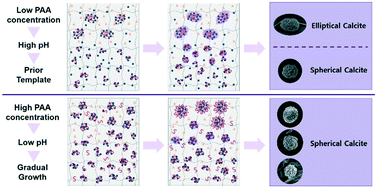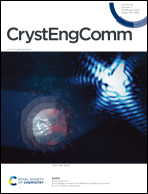Effect of poly(acrylic acid) on crystallization of calcium carbonate in a hydrogel†
Abstract
In a biological system, biomineralization is regulated via a controlled mass transfer as well as the assistance of soluble and insoluble macromolecules. Inspired by biomineralization, calcium carbonate morphologies were controlled by addition of anionic polyelectrolytes in a diffusion-limited matrix. As carbonate ions were slowly diffused into an agarose hydrogel containing calcium ions and poly(acrylic acid) (PAA), either elliptical or spherical calcites were formed depending on the concentration of PAA and the position of the hydrogel. It was proposed that calcium carbonate morphologies could be determined via the chain conformation of polyelectrolytes due to the initial pH. At a low PAA concentration, a steep increase of the initial pH led to anisotropic templates composed of stretched PAA, resulting in the formation of elliptical calcites. In contrast, at a high concentration of PAA, a slow increase of pH led to gradual growth of isotropic precursors, resulting in spherical calcites. Controlling the calcium carbonate crystallization in a diffusion-limited system is beneficial not only to understanding the biomineralization process in organic matrices, but also to producing calcite particles applicable to the industrial fields.



 Please wait while we load your content...
Please wait while we load your content...